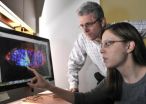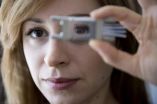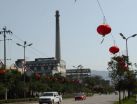(Press-News.org) That question is likely to stir debate in coming years in many of the more-than-60 countries that provide newborn screening, as whole-genome sequencing (WGS) becomes increasingly affordable and reliable. Newborn screening programs – which involve drawing a few drops of blood from a newborn's heel – have been in place since the late 1960s, and are credited with having saved thousands of lives by identifying certain genetic, endocrine or metabolic disorders that can be treated effectively when caught early enough. Advocates of routine WGS for newborns argue that the new technology could help detect and manage a wider array of disorders.
But the possibility of making whole-genome sequencing part of routine screening programs for newborns raises ethical, legal and social issues that should be weighed carefully, according to researchers at McGill University's Department of Human Genetics in Montreal.
In an article published March 26 in the journal Science Translational Medicine, Prof. Bartha M. Knoppers and colleagues lay out key questions and considerations to be addressed. "Any change in newborn screening programs should be guided by what's in the best interests of the child," says Prof. Knoppers, who is Director of the Centre of Genomics and Policy at McGill. "We must also tread carefully in interpreting the scientific validity and clinical usefulness of WGS results."
The researchers outline the following considerations:
What information to report? Using WGS in newborn screening could generate vast amounts of information – including incidental findings such as paternity information or reproductive risks. What's more, health-related information can include non-validated or poorly predictive results, or may involve adult-onset conditions. One possible solution: perform WGS but have a list of pediatric conditions to be communicated to parents; other results could be retrieved for later disclosure, when they gain scientific validity and clinical usefulness, or when they can be reported to the "mature" child directly.
Impact on health care systems. If WGS in newborn screening is implemented, public health care systems would have to be revamped to handle the massive amount of information generated. The added information could also lead to more false-positive results, imposing a big burden on families and on the resources of a health-care system.
Mandatory vs. voluntary. Most newborn screening programs currently are mandated by law or use presumed parental consent. Should parental consent be required for screening that doesn't stand to directly benefit the infant during childhood?
Educating health professionals and parents. Many doctors have little training in genetics, so health professionals and parents will need more education in genetics and genomics.
Communicating results over time. The validity of tests and the communication and understanding of results over time pose numerous challenges for doctors and families.
Ensuring treatment and follow-up. When treatment becomes available, a newborn screening report card would be invaluable on an individual basis, especially for single-gene disorders.
Validated variants. An important challenge in WGS is the ability to offer a standardized and accurate interpretation of genetic variants.
Storage of data. Should raw data be stored in the patient's file? If so, under what conditions and for how long?
Insurability. Data obtained through WGS newborn screening would be part of the medical record, potentially leading to issues regarding insurability.
"Without clear policy direction and public discussion on the possible future integration (or not) of WGS into newborn screening, more parents in years ahead may choose to pay for whole-genome sequencing through private testing services," says article co-author Karine Sénécal, an academic associate at the Centre of Genomics and Policy at McGill. "Medical and public education programs need to be put in place so that people understand the limits of whole-genome sequencing."
INFORMATION:
Prof. Denise Avard, Research Director for the Centre of Genomics and Policy, and Prof. Pascal Borry of the University of Leuven in Belgium, also co-authored the article.
For more information on the Centre of Genomics and Policy:
http://www.genomicsandpolicy.org/en
Should whole-genome sequencing become part of newborn screening?
Ethical, legal and social issues should be weighed before adopting the technology in public programs, researchers argue
2014-03-26
ELSE PRESS RELEASES FROM THIS DATE:
Solar System's edge redefined
2014-03-26
Washington, D.C.—The Solar System has a new most-distant member, bringing its outer frontier into focus.
New work from Carnegie's Scott Sheppard and Chadwick Trujillo of the Gemini Observatory reports the discovery of a distant dwarf planet, called 2012 VP113, which was found beyond the known edge of the Solar System. This is likely one of thousands of distant objects that are thought to form the so-called inner Oort cloud. What's more, their work indicates the potential presence of an enormous planet, perhaps up to 10 times the size of Earth, not yet seen, but possibly ...
Penn Dental Medicine-NIH team reverses bone loss in immune disorder
2014-03-26
Patients with leukocyte adhesion deficiency, or LAD, suffer from frequent bacterial infections, including the severe gum disease known as periodontitis. These patients often lose their teeth early in life.
New research by University of Pennsylvania School of Dental Medicine researchers, teaming with investigators from the National Institutes of Health, has demonstrated a method of reversing this bone loss and inflammation.
The work was led by Penn Dental Medicine's George Hajishengallis, professor in the Department of Microbiology, in collaboration with Niki Moutsopoulos ...
Researchers present comprehensive 'roadmap' of blood cells
2014-03-26
(WASHINGTON, March 26, 2014) – Research published online today in Blood, the Journal of the American Society of Hematology, presents an unprecedented look at five unique blood cells in the human body, pinpointing the location of key genetic regulators in these cells and providing a new tool that may help scientists to identify how blood cells form and shed light on the etiology of blood diseases.
Work published today in Blood* is a subset of a much larger catalog of genetic information about nearly 1,000 human cells and tissues unveiled today from the international research ...
3-D MRI scans may offer better way to predict survival after chemo for liver tumors
2014-03-26
In a series of studies involving 140 American men and women with liver tumors, researchers at Johns Hopkins have used specialized 3-D MRI scans to precisely measure living and dying tumor tissue to quickly show whether highly toxic chemotherapy – delivered directly through a tumor's blood supply – is working.
The investigators say their findings, to be presented March 22-27 in San Diego at the annual meeting of the Society of Interventional Radiology, are the first "proof of principle" that this technology can show tumors in three dimensions and accurately measure tumor ...
Lawrence Livermore scientists discover bacterial resistance to improve biofuel production
2014-03-26
Resistance is not futile when it comes to a new method to more efficiently convert biomass to biofuels.
New research by scientists from Lawrence Livermore National Laboratory in conjunction with the Joint BioEnergy Institute (JBEI) suggests that a type of bacterial resistance may provide more efficient production of biofuels.
The team identified the genetic origin of bacterial resistance to an ionic liquid (a salt in the liquid state), which they successfully introduced into a strain of E. coli bacteria for the production of advanced biofuels. The ionic liquid resistance ...
Significant progress toward creating 'benchtop human' reported
2014-03-26
Significant progress toward creating "homo minutus" - a benchtop human -was reported at the Society of Toxicology meeting on Mar. 26 in Phoenix.
The advance - successful development and analysis of a liver human organ construct that responds to exposure to a toxic chemical much like a real liver- was described in a presentation by John Wikswo, the Gordon A. Cain University Professor and Director of the Vanderbilt Institute for Integrative Biosystems Research and Education (VIIBRE) at Vanderbilt University.
The achievement is the first result from a five-year, $19 million ...
UT Southwestern cancer biologists link tumor suppressor gene to stem cells
2014-03-26
DALLAS – March 26, 2014 – Just as archeologists try to decipher ancient tablets to discern their meaning, UT Southwestern Medical Center cancer biologists are working to decode the purpose of an ancient gene considered one of the most important in cancer research.
The p53 gene appears to be involved in signaling other cells instrumental in stopping tumor development. But the p53 gene predates cancer, so scientists are uncertain what its original function is.
In trying to unravel the mystery, Dr. John Abrams, Professor of Cell Biology at UT Southwestern, and his team ...
Biological testing tool, ScanDrop, tests in fraction of time and cost of industry standard
2014-03-26
Northeastern University professor of pharmaceutical sciences, Tania Konry, has developed a single instrument that can conduct a wide range of biological scans in a fraction of the time and cost of industry standard equipment. That's because it uses considerably less material and ultra-sensitive detection methods to do the same thing.
Currently, researchers face enormous time constraints and financial hurdles from having to run these analyses on a regular basis. Hundreds of dollars and 24 hours are what's required to scan biological materials for important biomarkers that ...
Natural history must reclaim its place
2014-03-26
Support in developed countries for natural history—the study of the fundamental nature of organisms and how and where they live and interact with their environment—appears to be in steep decline. Yet natural history provides essential knowledge for fields as varied as human health, food security, conservation, land management, and recreation. In the April issue of BioScience, a group of scientists from institutions across North America details examples supporting their conviction that a revitalization of the practice of natural history will provide important benefits for ...
Coal plant closure in China led to improvements in children's health
2014-03-26
Decreased exposure to air pollution in utero is linked with improved childhood developmental scores and higher levels of brain-derived neurotrophic factor (BDNF), a key protein for brain development, according to a study looking at the closure of a coal-burning power plant in China led by researchers at the Columbia Center for Children's Environmental Health at the Mailman School of Public Health.
The study is the first to assess BDNF and cognitive development with respect to prenatal exposure to polycyclic aromatic hydrocarbons (PAH), a component of air pollution commonly ...
LAST 30 PRESS RELEASES:
Eye for trouble: Automated counting for chromosome issues under the microscope
The vast majority of US rivers lack any protections from human activities, new research finds
Ultrasound-responsive in situ antigen "nanocatchers" open a new paradigm for personalized tumor immunotherapy
Environmental “superbugs” in our rivers and soils: new one health review warns of growing antimicrobial resistance crisis
Triple threat in greenhouse farming: how heavy metals, microplastics, and antibiotic resistance genes unite to challenge sustainable food production
Earthworms turn manure into a powerful tool against antibiotic resistance
AI turns water into an early warning network for hidden biological pollutants
Hidden hotspots on “green” plastics: biodegradable and conventional plastics shape very different antibiotic resistance risks in river microbiomes
Engineered biochar enzyme system clears toxic phenolic acids and restores pepper seed germination in continuous cropping soils
Retail therapy fail? Online shopping linked to stress, says study
How well-meaning allies can increase stress for marginalized people
Commercially viable biomanufacturing: designer yeast turns sugar into lucrative chemical 3-HP
Control valve discovered in gut’s plumbing system
George Mason University leads phase 2 clinical trial for pill to help maintain weight loss after GLP-1s
Hop to it: research from Shedd Aquarium tracks conch movement to set new conservation guidance
Weight loss drugs and bariatric surgery improve the body’s fat ‘balance:’ study
The Age of Fishes began with mass death
TB harnesses part of immune defense system to cause infection
Important new source of oxidation in the atmosphere found
A tug-of-war explains a decades-old question about how bacteria swim
Strengthened immune defense against cancer
Engineering the development of the pancreas
The Journal of Nuclear Medicine ahead-of-print tip sheet: Jan. 9, 2026
Mount Sinai researchers help create largest immune cell atlas of bone marrow in multiple myeloma patients
Why it is so hard to get started on an unpleasant task: Scientists identify a “motivation brake”
Body composition changes after bariatric surgery or treatment with GLP-1 receptor agonists
Targeted regulation of abortion providers laws and pregnancies conceived through fertility treatment
Press registration is now open for the 2026 ACMG Annual Clinical Genetics Meeting
Understanding sex-based differences and the role of bone morphogenetic protein signaling in Alzheimer’s disease
Breakthrough in thin-film electrolytes pushes solid oxide fuel cells forward
[Press-News.org] Should whole-genome sequencing become part of newborn screening?Ethical, legal and social issues should be weighed before adopting the technology in public programs, researchers argue




